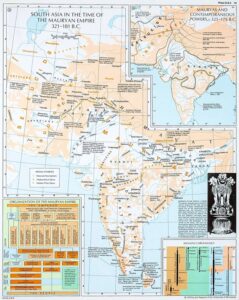Introduction
The third Mauryan emperor Ashoka, sometimes referred to as Ashoka the Great, reigned in ancient India from 268 to 232 BC. He was the second son of the Mauryan emperor Bindusar. Although he was not the heir of the Mauryan throne, he was more adored than his elder brother Sushima. Ashoka was an ambitious ruler and a gallant warrior. Some folklores suggest that Ashoka conspired against all his siblings to reach the throne. However, he is not only known for his war abilities but for the realizations he had after the war of Kalinga that led him to accept the doctrines of Buddhism and spread peace around the world.

Ashoka: The Great
Ashoka was born in the year 304 BC to Subhadrangi, daughter of a Brahmin. It is said that Ashoka spent his childhood away from the royal pleasures and in a village. However, he was trained with good morale and this made him popular among the crowd. He was loved by his people and received titles of honor from them. For several reasons, Ashoka was referred to as Ashoka the Great. Some of them are as follows:
- The largest empire in the Indian subcontinent was founded by Ashoka.
- One of the largest armies was that of Ashoka, which included infantry, cavalry, and war elephants.
- The greatest conquistador was Ashoka. He resolved never to use violence again after the Kalinga conflict and gave his life to Buddhism.
- He dispatched his son, daughter, and many missionaries to spread Buddhism over the continent.
- He constructed countless viharas and stupas, the most notable of which is the enormous Sanchi Stupa, which UNESCO has listed as a World Heritage Site.
Ashoka: The Ruler
- Following his accession to the throne, Ashoka decided to expand his empire and carried out all the royal responsibilities outlined in Kautilya’s Arthashastra.
- This ongoing conflict lasted for eight years. Aside from these battles, he maintained good relations with other countries and maintained stability in all the regions that Chandragupta and Bindusar had previously controlled.
- He gave himself the name “Devanampriya,” which means gods’ favourite.
- Kashmir and Kalinga, the only left-wing state in south India, were two targets Ashoka had long aimed to capture. His efforts were concentrated on Kalinga after he was successful in annexing Kashmir. The conflict significantly altered Ashoka’s life.
Ashoka’s War
The War of Kalinga was the largest and most well-known conflict during Ashoka’s rule. The Kalinga kingdom was a commercial state with easy access to the sea that was located in what is now the state of Odisha. In the year 260 BCE, Ashoka attacked Kalinga city.
In India’s history, it was the bloodiest conflict ever. When Ashoka visited the battlefield to celebrate his victory after winning the war, he was horrified and deeply saddened by the scale of the carnage. At that very moment, he experienced a great conversion of heart and condemned war and all forms of violence after witnessing the devastation and feeling regret for the Kalinga. He swore he would never take up a weapon or use force of any kind. He subsequently adopted Buddhism as his religion, followed its path, and swore to disseminate the Buddha’s teachings.
Ashoka as a Devotee
Ashoka was dramatically altered by the Kalinga conflict. He converted to Buddhism and embraced the Dhamma, or Conquest by Dharma, philosophy. Ashoka erected several engraved rock and pillar edicts and thousands of stupas around India to publicise Buddha’s work and propagate his teachings.
For people to adhere to the teachings and uphold the dharma, Ashoka’s rules and the Buddha’s teachings were etched on those pillars. One of the best-known dicta of dharma is the lion capital of the pillar at Sarnath, which eventually became the flag of India. Ashoka gave the order to erect 84,000 stupas throughout his territory, each housing the Buddha’s remains. Sanchi Stupa is among the most well-known stupas.

Ashoka’s Administration:
- The kingdom of Ashoka was split into provinces, which were further subdivided into villages by Visayas and Janpadas.
- The provinces of his dominion were separated into five.
- Magadh was the central Province, and each Province was independent, given a certain amount of autonomy.
- He adhered to the ideal of non-violence and had as his goal the welfare and security of his citizens.
- Amatya and appointed officials, who all directly answered to the king, were trusted and knowledgeable authorities in charge of overseeing all administrative and judicial functions.
- He had a competent and organised government.
Summary
One of the most amazing and legendary monarchs of ancient India was Ashoka. He gained much of his notoriety following the Battle of Kalinga when he decided to stop fighting. As the monarch who abstained from battle, he is well-known throughout history. Ashoka ruled over the whole Indian subcontinent and created the largest empire in historical India. After the Battle of Kalinga, he converted to Buddhism and became its most ardent supporter. To promote the teachings of Buddhism, he dispatched many missionaries and carved numerous stone edicts.
Frequently Asked Questions (FAQs)
1.What was Ashoka’s Dhamma?
Ans. Dhamma is best understood as instructions, and Ashoka’s Dhamma were guidelines for a more ethical social order. It was an order that needed to be obeyed for the good of society.
2.What were the messages given by Ashoka for the Betterment of Society?
Ans. The messages given by Ashoka for the betterment of society were:
- Respecting everyone’s cast.
- Being gentle with the poor.
- Doing welfare of citizens.
- Respecting each religion.
3. Where is Kalinga located in Present Day?
Ans: Kalinga included a large part of present-day Odisha, north-easter regions of Andhra Pradesh, and large portions of Chhatisgarh.